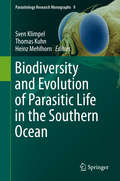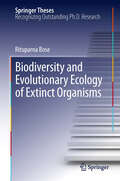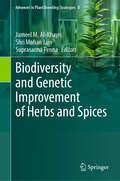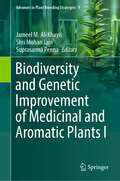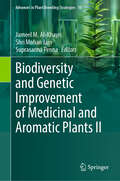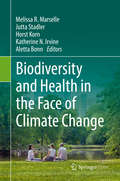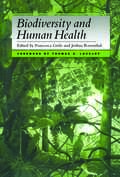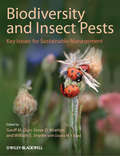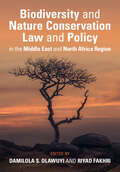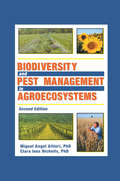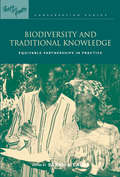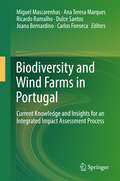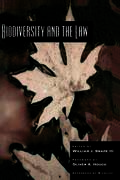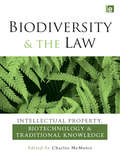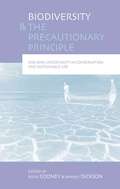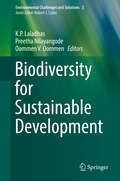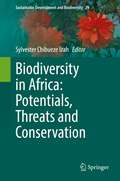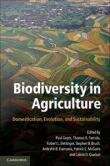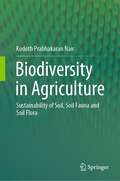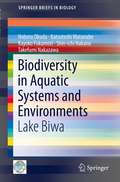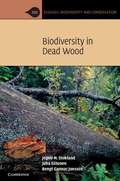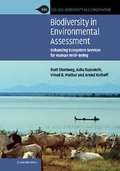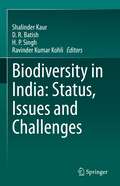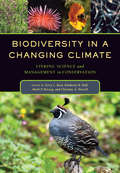- Table View
- List View
Biodiversity and Evolution of Parasitic Life in the Southern Ocean (Parasitology Research Monographs #9)
by Sven Klimpel Heinz Mehlhorn Thomas KuhnThe Southern Oceans including Antarctic regions are peculiar and very sensitive water biotopes, where animal life and species interrelations are only poorly investigated. Especially the influence of parasites on their host species needs intensive consideration in times of global warming and worldwide pollution. Both factors may influence the finely balanced interrelationships between parasites and endangered hosts especially in specialized regions such as Antarctica. Before this background the present book offers a broad spectrum of important parasite-host interrelations in times of ecosystem changes written by experienced and renown international specialists.
Biodiversity and Evolutionary Ecology of Extinct Organisms (Springer Theses)
by Rituparna BoseIncreasing rate of species extinction in the present day will lead to a huge biodiversity crisis; eventually, this will lead to the paucity of non-renewable resources of energy making our Earth unsustainable in future. To save our mother planet from this crisis, studies need to be performed to discover abundant new fossil sites on Earth for continued access to oil-rich locations. Most importantly, a holistic approach is necessary in solving the present problem of biodiversity loss. This book presents newly developed quantitative models in understanding the biodiversity, evolution and ecology of extinct organisms. This will assist future earth scientists in understanding the natural and anthropogenic causes behind biodiversity crisis and ecosystem collapse. In addition, this study would be of great interest to exploration geologists and geophysicists in potentially unraveling natural resources from our sustainable Earth.
Biodiversity and Genetic Improvement of Herbs and Spices (Advances in Plant Breeding Strategies #8)
by Shri Mohan Jain Jameel M. Al-Khayri Suprasanna PennaThe herbs and spices plants have immensely benefited humankind since ancient times for therapeutic, cosmetic, and nutritional properties. The wealth of information on genetic resources, breeding, conservation, propagation, cultivation, and biotechnological strategies is crucial for plant improvement. This volume consists of 19 chapters covering research advances in conventional and modern breeding technologies of various important herbs and spices individually, including Basil, Bay leaf, Cinnamon, Coriander, Dill, Lemongrass, Long pepper, Nutmeg, Onion, Oregano, Parsley, Pepper, Saffron, Sage, Sesame, Tarragon, Thyme, Common turmeric, and Scentless turmeric. Chapters are written by globally renowned scientists and subjected to a rigorous review process to ensure quality presentation and scientific precision. Each chapter has an introduction covering related backgrounds and provides an in-depth discussion of the subject supported with high-quality color photos, illustrations and relevant data. The chapter concludes with future research directions and pertinent references to facilitate further reading. The book is an excellent reference source for plant breeders, biotechnologists and geneticists engaged in breeding and improvement. The book is suitable for both advanced undergraduate and postgraduate students specializing in agriculture, biotechnology, and molecular breeding as well as for seed companies.
Biodiversity and Genetic Improvement of Medicinal and Aromatic Plants I (Advances in Plant Breeding Strategies #9)
by Shri Mohan Jain Jameel M. Al-Khayri Suprasanna PennaThe medicinal and aromatic plants have immensely benefited humankind since ancient times for therapeutic, cosmetic, and nutritional properties. The wealth of information on genetic resources, breeding, conservation, propagation, cultivation, and biotechnological strategies is crucial for plant improvement. This volume consists of 12 chapters covering research advances in conventional and modern breeding technologies of various medicinal and important aromatic plants individually, including Brahmi, Barberry, Betel, Blond plantain, Caper, Chinese woad, Common hop, Damask rose, Deadly, Echinacea, Ginkgo, and Gymnema. Chapters are written by globally renowned scientists and subjected to a rigorous review process to ensure quality presentation and scientific precision. Each chapter has an introduction covering related backgrounds and provides an in-depth discussion of the subject supported with high-quality color photos, illustrations and relevant data. The chapter concludes with future research directions and pertinent references to facilitate further reading. The book is an excellent reference source for plant breeders, biotechnologists and geneticists engaged in breeding and improvement. The book is suitable for both advanced undergraduate and postgraduate students specializing in agriculture, biotechnology, and molecular breeding as well as for seed companies.
Biodiversity and Genetic Improvement of Medicinal and Aromatic Plants II (Advances in Plant Breeding Strategies #10)
by Shri Mohan Jain Jameel M. Al-Khayri Suprasanna PennaThe medicinal and aromatic plants have immensely benefited humankind since ancient times for therapeutic, cosmetic, and nutritional properties. The wealth of information on genetic resources, breeding, conservation, propagation, cultivation, and biotechnological strategies is crucial for plant improvement. This volume consists of 13 chapters covering research advances in conventional and modern breeding technologies of various medicinal and important aromatic plants individually, including Indian ginseng, Datura, Licorice, Marjoram, Moringa, Neem, Opium poppy, Patchouli, Persian shallot, Plumbago, St John's-wort, Stevia, and Upastree resin. Chapters are written by globally renowned scientists and subjected to a rigorous review process to ensure quality presentation and scientific precision. Each chapter has an introduction covering related backgrounds and provides an in-depth discussion of the subject supported with high-quality color photos, illustrations and relevant data. The chapter concludes with future research directions and pertinent references to facilitate further reading. The book is an excellent reference source for plant breeders, biotechnologists and geneticists engaged in breeding and improvement. The book is suitable for both advanced undergraduate and postgraduate students specializing in agriculture, biotechnology, and molecular breeding as well as for seed companies
Biodiversity and Health in the Face of Climate Change
by Aletta Bonn Horst Korn Jutta Stadler Melissa R. Marselle Katherine N. IrvineThis open access book identifies and discusses biodiversity’s contribution to physical, mental and spiritual health and wellbeing. Furthermore, the book identifies the implications of this relationship for nature conservation, public health, landscape architecture and urban planning – and considers the opportunities of nature-based solutions for climate change adaptation. This transdisciplinary book will attract a wide audience interested in biodiversity, ecology, resource management, public health, psychology, urban planning, and landscape architecture. The emphasis is on multiple human health benefits from biodiversity - in particular with respect to the increasing challenge of climate change. This makes the book unique to other books that focus either on biodiversity and physical health or natural environments and mental wellbeing. The book is written as a definitive ‘go-to’ book for those who are new to the field of biodiversity and health.
Biodiversity and Human Health
by Bhaswati Bhattacharya Mary Campbell Jensa Bell Michael Boyd Eric Chivian Paul CoxThe book provides a common framework for physicians and biomedical researchers who wish to learn more about environmental concerns, and for members of the environmental community who desire a greater understanding of biomedical issues.
Biodiversity and Insect Pests: Key Issues for Sustainable Management
by Geoff M. Gurr Stephen D. Wratten William E. SnyderBiodiversity offers great potential for managing insect pests. It provides resistance genes and anti-insect compounds; a huge range of predatory and parasitic natural enemies of pests; and community ecology-level effects operating at the local and landscape scales to check pest build-up. This book brings together world leaders in theoretical, methodological and applied aspects to provide a comprehensive treatment of this fast-moving field. Chapter authors from Europe, Asia, Africa, Australasia and the Americas ensure a truly international scope. Topics range from scientific principles, innovative research methods, ecological economics and effective communication to farmers, as well as case studies of successful use of biodiversity-based pest management some of which extend over millions of hectares or are enshrined as government policy. Written to be accessible to advanced undergraduates whilst also stimulating the seasoned researcher, this work will help unlock the power of biodiversity to deliver sustainable insect pest management. Visit www.wiley.com/go/gurr/biodiversity to access the artwork from the book.
Biodiversity and Nature Conservation Law and Policy in the Middle East and North Africa Region
by Damilola S. Olawuyi Riyad FakhriThis book offers a comprehensive and authoritative account of the guiding principles and rules relating to biodiversity, nature conservation, and the protection of cultural heritage in the MENA region. The book introduces readers to the applicable legislation, institutions and rules underpinning the design, approval, financing and implementation of biodiversity and nature-based solutions across the MENA region. It also explores larger questions on legal and institutional frameworks that can help address broader issues of fragmentation, gender inequality, inadequate stakeholder engagement, lack of transparency, limited access to environmental information, and lack of comprehensive domestic legislation, all of which stifle the integrated implementation of biodiversity and nature conservation treaties and the equitable sharing of the benefits derived from biodiversity and nature in the region. Written in a user-friendly style, the book closes with recommendations and reflections on legal and regulatory innovations for advancing biodiversity and nature-based solutions in the MENA region. This title is also available as open access on Cambridge Core.
Biodiversity and Pest Management in Agroecosystems
by Miguel Altieri Clara NichollsExplore the latest research on biological control! Completely updated for 2004, this new edition examines methods for making agricultural systems less susceptible to insect pests. Containing new findings and reports of strategies, Biodiversity and Pest Management in Agroecosystems, Second Edition will show you how pests can be managed by enhancing beneficial biodiversity using agroecological diversification methods. Biodiversity and Pest Management in Agroecosystems, Second Edition provides you with an essential overview of the role of biodiversity in agriculture and then gets specific, with new and updated information on: the agroecology of pest management plant diversity and pest outbreaks within agroecosystems diversification strategies for pest management how sustainable farming systems are designed You'll also explore: the role of plant diversity on the biology of beneficial insects insect regulation in diverse agroecosystems manipulation of plant diversity in agroecosystems ecological and socioeconomic implications The fact is, many modern agroecosystems are unstable as a consequence of constant human intervention in crop systems which ignore ecological principles. With case studies on a variety of crops and pests, Biodiversity and Pest Management in Agroecosystems, Second Edition explores entomological aspects of agriculture and analyzes the ecological basis for the maintenance of biodiversity. It will familiarize you with the theory and practice of enhancing biological pest control in agricultural systems by managing vegetational diversity via multiple cropping, cover cropping, rotations, and other spatial and temporal designs. With studies on intercropping, cover cropping, weed management, and crop-field border vegetation manipulation, this book covers the effects of these diverse systems on pest population density and the mechanisms underlying pest reduction in polycultures. Make it a part of your reference/teaching collection today!
Biodiversity and Traditional Knowledge: Equitable Partnerships in Practice (People And Plants International Conservation Ser.)
by Sarah A. LairdBiodiversity research and prospecting are long-standing activities taking place in a new legal and ethical environment. Following entry into force of the Convention on Biological Diversity in 1993, and other recent policy developments, expectations and obligations for research and prospecting partnerships have changed. However, to date there are few guides to integrating these concepts with practice. This book offers practical guidance on how to arrive at equitable biodiversity research and prospecting partnerships. Drawing on experience and lessons learned from around the world, it provides case studies, analysis and recommendations in a range of areas that together form a new framework for creating equity in these partnerships. They include researcher codes of ethics, institutional policies, community research agreements, the design of more effective commercial partnerships and biodiversity prospecting contracts, the drafting and implementation of national 'access and benefit-sharing' laws, and institutional tools for the distribution of financial benefits. As part of the People and Plants initiative to enhance the role of communities in efforts to conserve biodiversity and use natural resources sustainably, Biodiversity and Traditional Knowledge will be invaluable to students, researchers and local communities, academic institutions, international agencies, government bodies and companies involved in biodiversity research, prospecting and conservation.
Biodiversity and Wind Farms in Portugal: Current knowledge and insights for an integrated impact assessment process
by Miguel Mascarenhas Ana Teresa Marques Ricardo Ramalho Dulce Santos Joana Bernardino Carlos FonsecaThis book presents a review of the state-of-the-art knowledge on the interactions between biodiversity and wind energy development, focused on the Portuguese reality. The volume addresses the particularities of the impact assessment procedures in Portugal, contrasting it with the international practices and presenting its main findings by covering the following broader themes: i) evaluation of spatial and temporal dynamics of wildlife affected by wind farms, including birds, bats and terrestrial mammals (in particularly Portuguese wolf population); ii) the methodologies used to assess impacts caused by this type of developments in biodiversity; iii) the best practice methodologies to implement an adaptive management approach to reconcile biodiversity and wind farms. The knowledge presented in this book was gathered through the research and development activities developed by Bioinsight company (former Bio3 company) during the last 13 years and partially funded by a R&D project designated as "Integrated solutions for biodiversity management at wind farms: reduce and compensate bird and bat mortality" (acronym: Wind & Biodiversity), co-funded by the European Regional Development Fund (FEDER), under the Regional Operational Programme of Centre (Mais Centro). This volume fills a void in the literature as a book giving insights on the best practices to install and manage a wind farm from a biodiversity management point of view, while establishing a commitment between economic sustainability and biodiversity conservation.
Biodiversity and the Law
by Mollie Beattie Scott Hajost John Pendergrass Jason Patlis Leesteffy Jenkins Dinah BearBiodiversity and the Law is a timely and provocative volume that combines historical perspective and cutting-edge legal analysis in an authoritative and broad discussion of biodiversity and the law. Leading legal and policy experts consider a variety of options for the worldwide protection of biodiversity and present a succinct but comprehensive overview of the legal mechanisms available. They examine how conservation advocates can better utilize existing law, and consider what new law is needed.Among the topics considered are: scientific and policy foundations of biodiveristy protection domestic efforts to establish an effective endangered species protection regime international biodiversity protection biodiversity as a genuinely public entity the future of biodiversity law Contributors include Mollie Beattie, Don Waller, Jason Patlis, Lindell Marsh, Todd Olson, Peter Jenkins, Suzanne Iudicello, John Pendergrass, Dinah Bear, Walter Kuhlmann, Rodger Schlickeisen, David Downes, and others.
Biodiversity and the Law: "Intellectual Property, Biotechnology and Traditional Knowledge"
by Charles R. McManisHow do we promote global economic development, while simultaneously preserving local biological and cultural diversity? This authoritative volume, written by leading legal experts and biological and social scientists from around the world, aims to address this question in all of its complexity. The first part of the book focuses on biodiversity and examines what we are losing, why and what is to be done. The second part addresses biotechnology and looks at whether it is part of the solution or part of the problem, or perhaps both. The third section examines traditional knowledge, explains what it is and how, if at all, it should be protected. The fourth and final part looks at ethnobotany and bioprospecting and offers practical lessons from the vast and diverse experiences of the contributors.
Biodiversity and the Precautionary Principle: Risk, Uncertainty and Practice in Conservation and Sustainable Use
by Barney Dickson Rosie CooneyGreat uncertainty typically surrounds decisions and management actions in the conservation of biodiversity and natural resource management, and yet there are risks of serious and irreversible harm for both biodiversity and the humans that rely on it. The precautionary principle arguably underlies all international conservation efforts and promotes acting to avoid serious or irreversible environmental harm, despite lack of scientific certainty as to the likelihood, magnitude or cause of harm. This book is the first to examine the application of the precautionary principle to biodiversity conservation and natural resource management, incorporating perspectives from scientists, economists, lawyers and practitioners from both developing and developed countries. It analyses the application and impacts of the principle in many areas including forestry, invasive alien species, wildlife trade, protected areas and fisheries, in a range of national and international contexts. Particular attention is drawn to issues of equity, livelihoods, science and politics, and the book provides guidelines for applying the precautionary principle to biodiversity conservation and natural resource management.
Biodiversity at Risk: Today’s Choices Matter
by Ocean Studies Board Institute for Laboratory Animal Research Board on Agriculture and Natural Resources Division on Earth and Life Studies Board on Life Sciences Board on Atmospheric Sciences and Climate National Academies of Sciences, Engineering, and Medicine Board on Environmental Sciences and Toxicology Committee on Developing a Booklet on Biodiversity for the Public and Policy MakersA growing body of evidence has sounded the alarm that the biodiversity that supports and sustains life on Earth is at risk. Habitat destruction, resource exploitation, and climate change are among the many stressors that have put 1 million species under threat of extinction and sharply reduced the populations of many plant and animal species. While researchers and global leaders ramp up efforts to address this existential threat, the significance of species loss and the value of preserving biodiversity is not widely recognized by policy makers or the public. This booklet, produced by an international committee of experts, provides a publicly accessible overview of the many dimensions of biodiversity and why it's vital to the health of all life on the planet. The booklet also examines the causes of biodiversity loss and presents actions that can be taken from the individual to the global level to stop this decline.
Biodiversity for Sustainable Development (Environmental Challenges and Solutions #3)
by K. P. Laladhas Preetha Nilayangode Oommen V. OommenDivided into three sections, this book explores the three main pillars of sustainable development, namely economy, environment and society, and their interlinkages at the regional level. The first section, Access and Benefit Sharing (ABS) for sustainable development, focuses on international agreements and national legislation, as well as the challenges in implementing ABS in e. g. India. In turn, the second section examines the process of forming Biodiversity Management Committees (BMCs) at the Local Self Government (LSG) level to promote environmental sustainability, highlighting local and community-level conservation initiatives that have led to the conservation of habitats and species. The third section addresses poverty eradication and food security. The case studies included demonstrate how the combination of traditional knowledge and modern techniques can enhance the productivity of traditional crop varieties, yielding greater benefits for communities. The aim of this volume is to disseminate the lessons learned from these case studies, as well as the findings from projects already in place, which can offer recommendations that can be applied to similar problems elsewhere in an attempt to find environmental solutions for sustainable development. Further, it introduces readers to new approaches to inclusive development, demonstrating that participation and grass root empowerment are key drivers of equitable and sustainable development.
Biodiversity in Africa: Potentials, Threats and Conservation (Sustainable Development and Biodiversity #29)
by Sylvester Chibueze IzahThis edited work brings out a comprehensive collection of information on Potentials, Threats and Conservation of Biodiversity in Africa. The main focus of this book is to address the sustainability of Biodiversity of Africa.Biodiversity are organisms that typically have life and possess the characteristics of living things. The biodiversity is being affected by human activities as well as natural effects. This in turn is affecting the uses of biodiversity which are mainly food and medicine. Therefore it will be useful to point possible means of conserving biodiversity of African so as to enhance the sustainability of their uses especially in Africa. This book is of interest and useful to biodiversity experts, policy makers, conservationists and industries interested in biodiversity conservation of native flora and fauna in the area. It will also be useful to environmental and agricultural scientists, foresters, horticulturists, ecologists, and valuable source of reference to the relevant researchers and students (undergraduate and Post graduate) in the region.
Biodiversity in Agriculture
by Robert L. Bettinger Paul Gepts Stephen B. Brush Patrick E. Mcguire Thomas R. Famula Calvin O. Qualset Ardeshir B. DamaniaThe introduction of plant and animal agriculture represents one of the most important milestones in human evolution. It contributed to the development of cities, alphabets, new technologies, and ultimately to civilizations, but it has also presented a threat to both human health and the environment. Bringing together research from a range of fields including anthropology, archaeology, ecology, economics, entomology, ethnobiology, genetics and geography, this book addresses key questions relating to agriculture. Why did agriculture develop and where did it originate? What are the patterns of domestication for plants and animals? How did agroecosystems originate and spread from their locations of origin? Exploring the cultural aspects of the development of agricultural ecosystems, the book also highlights how these topics can be applied to our understanding of contemporary agriculture, its long-term sustainability, the co-existence of agriculture and the environment, and the development of new crops and varieties.
Biodiversity in Agriculture: Sustainability of Soil, Soil Fauna and Soil Flora
by Kodoth Prabhakaran NairThis book begins with the principal subject of biodiversity in agriculture. The onslaught of highly soil extractive chemical farming, euphemistically called the “green revolution”, has taken a heavy toll on soil biodiversity, hence, soil sustenance. Agrobiodiversity is a key resource for humanity. All of the food requirements humanity depends on are met by agrobiodiversity. Similarly, fodder fiber, firewood, and many other basic needs of humankind are also met by agrobiodiversity. The book puts forward ideas on how we are to develop a sustainable future, to provide a healthy and thriving environment for humanity by protecting, conserving, and augmenting agrobiodiversity.The pedosphere, the outermost layer of the Earth, composed of soil and subject to soil formation processes, is an integral component of biosphere, lying on the interface of the atmosphere, hydrosphere, and lithosphere and a lot more complex in its physicochemical and biological characteristics and functioning and quite distinguishable from that of the above soil-surface terrestrial and aquatic ecosystems. The biotic component of the pedosphere comprises a rich biodiversity of living species, dominated by microorganisms. This book considers and discusses the influences of soil formation processes.This book will be of interest to those engaged in researching biodiversity, agriculture, and crop science.
Biodiversity in Aquatic Systems and Environments: Lake Biwa (SpringerBriefs in Biology)
by Noboru Okuda Katsutoshi Watanabe Kayoko Fukumori Shin-Ichi Nakano Takefumi NakazawaThis book presents the latest topics in ecological and evolutionary research on aquatic biodiversity from bacteria to fishes, with special reference to Lake Biwa, an ancient lake in western Japan. With a geological history of 4 million years, Lake Biwa is the third oldest lake in the world. It is considered a biodiversity hotspot, where 1,769 aquatic species including 61 endemics are recorded, providing a rare opportunity to study the evolutionary diversification of aquatic biota and its ecological consequences. The first chapter introduces the evolutionary history of biodiversity, especially of fish in this lake. In the second chapter, some examples of trophic polymorphism in fish are described. Fish are keystone predators in lake ecosystems, and they can be a major driver for altering biological communities through their top-down trophic cascading effects. An excellent laboratory experiment is presented, demonstrating that functional diversity of fish feeding morphology alters food web properties of plankton prey communities. The third chapter focuses on aquatic microbes, whose abundance and diversity may also be influenced by the diversity of fish through top-down trophic cascades. Aquatic microbes can have a strong impact on ecosystem functioning in lakes, and in this chapter, the latest molecular techniques used to examine genetic and functional diversity of microbial communities are introduced. The final chapter presents theoretical frameworks for predicting how biodiversity has the potential to control the incidence and intensity of human-induced regime shifts. While respecting the precious nature of biodiversity in lakes, it is essential to be aware that modern human activities have brought a crisis of biodiversity loss in lakes worldwide. Throughout this book, readers will learn why biodiversity must be conserved at all levels, from genes to ecosystems.
Biodiversity in Dead Wood
by Jogeir N. Stokland Juha Siitonen Bengt Gunnar JonssonFossils document the existence of trees and wood-associated organisms from almost 400 million years ago, and today there are between 400,000 and 1 million wood-inhabiting species in the world. This is the first book to synthesise the natural history and conservation needs of wood-inhabiting organisms. Presenting a thorough introduction to biodiversity in decaying wood, the book studies the rich diversity of fungi, insects and vertebrates that depend upon dead wood. It describes the functional diversity of these organisms and their specific habitat requirements in terms of host trees, decay phases, tree dimensions, microhabitats and the surrounding environment. Recognising the threats posed by timber extraction and forest management, the authors also present management options for protecting and maintaining the diversity of these species in forests as well as in agricultural landscapes and urban parks.
Biodiversity in Environmental Assessment
by Roel Slootweg Asha Rajvanshi Vinod B. Mathur Arend KolhoffHuman induced development activities are introduced with insufficient attention to their consequences for our living environment, even in cases where environmental assessments have been carried out. This apparent lack of attention to biodiversity in environmental assessment is rooted in the difficulties we have in adequately addressing biodiversity within the scope, time frame and budget allocated for assessments. This book provides a conceptual background and practical approaches to overcome these difficulties. It integrates the objectives of the Convention on Biological Diversity, its ecosystem approach, and the conceptual framework of the Millennium Ecosystem Assessment into a comprehensive approach to biodiversity in environmental assessment. It highlights the need to consider the value of biodiversity based on its use by each stakeholder, addresses the importance of both social and economic development to reach the Millennium Development Goals, and provides insights into ways to balance present and future needs.
Biodiversity in India: Status, Issues and Challenges
by Shalinder Kaur D. R. Batish H. P. Singh Ravinder Kumar KohliThis contributed book is based on the current status of biodiversity in India, issues and challenges faced by the authorities involved in conservation efforts, and the imperative role of various direct and indirect stakeholders in biodiversity conservation. The book discusses the current status of different forms of biodiversity in India, challenges faced by stakeholders, issues and reasons for biodiversity losses, and efforts by government through various laws, policies, and programs in a concise and comprehensive manner throughout its many chapters. In this way, readers can access diverse information on Indian biodiversity through this book. It is compiled by leading experts in the field of conservation. In 18 chapters, it covers biodiversity of both fauna and flora, on land and in aquatic ecosystems, legal and policy aspects, as well as innovative conservation tool and techniques. It is useful for undergraduates and graduate students and also educates policy planners, bureaucrats, foresters, and researchers in India and abroad.
Biodiversity in a Changing Climate
by Kimberly R. Hall Christine A. Howell Mark P. Herzog Terry Louise RootOne major consequence of climate change is abrupt, dramatic changes in regional biodiversity. Even if the most optimistic scenarios for mitigating climate change transpire, the fate of many wild species rests on the shoulders of people engaged in conservation planning, management, and policy. Providing managers with the latest and most useful climate change research is critical and requires challenging the conventional divide between scientists and managers.Biodiversity in a Changing Climate promotes dialogue among scientists, decision makers, and managers who are grappling with climate-related threats to species and ecosystems in diverse forms. The book includes case studies and best practices used to address impacts related to climate change across a broad spectrum of species and habitats--from coastal krill and sea urchins to prairie grass and mountain bumblebees. Focused on California, the issues and strategies presented in this book will prove relevant to regions across the West, as well as other regions, and provide a framework for how scientists and managers in any region can bridge the communication divide to manage biodiversity in a rapidly changing world.Biodiversity and a Changing Climate will prove an indispensable guide to students, scientists, and professionals engaged in conservation and resource management.
